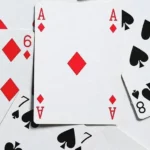Conceding might not feel great but sometimes it’s the most strategic move, especially in casino card games like blackjack. When presented with your hand, you're hoping for a lucky pair. However, when the tide turns, why not retain half of your initial wager instead of forfeiting the lot? Blackjack offers you this tactical option - blackjack surrender. Remember, the art of blackjack is more of a marathon. Even if you don’t win immediately, your chances protractively improve. So, how do you integrate surrender smartly in blackjack to keep your gameplay sharp?
Evaluating Blackjack Surrender: When is it Wiser to End Your Game?
Last update: February, 2025

Basic Rules of Playing Blackjack
Before diving deeper, let’s understand the fundamental gameplay rules. The game pits players against a dealer with the sole aim of outplaying them. Both receive two cards; the dealer reveals one. Players then choose between taking further cards or sticking with their existing ones.
Card values are assigned from 2-10 for numbered cards, with 10 given to face cards. Hands incorporating an Ace are 'soft', while those without are 'hard': like soft 17, hard 17, or hard 14. Points determine who claims victory.
Achieving 21 is the ultimate aim, but exceeding this by drawing more cards results in a loss. Typically, an 8-deck blackjack is standard though the deck count isn’t fixed. This variability impacts odds, and players may split cards when favorable. Determining if the dealer acts on soft hands is also outlined in rules.
Surrender in Blackjack: What Is It?
As players target superior hands against dealers, poor cards and slim winning odds may usher the surrender option. Recognizing a weak hand post-bets, blackjack tables extend relief via surrender as a viable tactic.
In simple terms, surrender allows players to bow out prior to complete loss, recouping half their stake. This comes in two forms, often contingent on dealer checks. If blackjack is revealed, surrender isn’t viable.
The core strategy leverages surrender when specific player-dealer card setups arise. We’ll explore when it’s prudent to utilize surrender to augment your chances, irrespective of deck count.
Types of Online Blackjack Surrender
While digital casinos may only offer one variant, certain physical venues extend both. We’ll dissect early and late surrender: their distinctions, merits, drawbacks, and pertinent scenarios.
Early Surrender
The rarity of early surrender stems from a 0.63% dip in house edge, undesirable to operators. Casinos offering this mitigate discrepancy through stringent conditions.
Early surrender lets players concede post-dealing, sans dealer card reviews, thus avoiding further risks and securing a partial refund.
Late Surrender
Late surrender is prevalent in most venues, beneficial albeit not as favorable. Here, dealers verify their hand pre-surrender. If blackjack exists, the game closes for all, though ties can occur if mirrored hands exist.
Advice: When in a land-based casino, inquire about late surrender’s availability. Being uninformed could lead to unnecessary losses, missing out on strategic surrender advantages.
When Should You Surrender?
In blackjack, various elements may adjust your strategy. Predominantly, it is contingent on the surrender timing dictated by casino rules (early or late), coupled with both your and the dealer's cards.
Initially, analyze scenarios necessitating early surrender.
- When facing an Ace from the dealer and holding a tough hand like 5-7 or 12-17.
- Holding pairs like 3-3, 6-6, 7-7, or 8-8, typically split for better odds, though not against a soft dealer hand, especially if an Ace is present.
- Should the dealer flaunt a Ten and you possess 14-16 points, surrender might be judicious.
Instances fit for late surrender encompass.
- When the dealer flaunts a 10 or Ace, countering with a modest 16.
- Should the dealer’s Ace confront your 15.
- If you cradle 17 against an Ace-wielding dealer’s hand (bypass if soft 17 demands a hit).
Avoid surrender in scenarios boosting online winnings, like.
- If the dealer holds on a soft 17, armed with 9, 10, or an Ace.
- When you have 16 against the dealer’s 9.
Summary
To summarize, strategic surrender enhances safety and bolsters playtime with robust hands, effectively double-staking your original bet prospects. In weak situations, reclaim half your bet instead. Adhering to strategy based on your and the dealer’s hands, employ these guidelines to make surrender a savvy tool in online blackjack. We hope fortune favors you with strong hands!
FAQ
What is blackjack surrender?
Concise summary: Blackjack surrender offers gamblers a reprieve, allowing them to review their hand, escape with half their wager when it falters, instead of risking full losses. A far better approach than enduring with an unfavorable hand.
What categories of blackjack surrender can one discover?
Two primary versions exist: early and late surrender. Yet, most blackjack tables and games, especially online, predominantly support just the latter since the former drastically undercuts the house edge.
At what point is surrender in blackjack a smart move?
Factors dictating surrender importance include both dealer and player cards plus deck count. Ensure clarity if dealers assess their cards (early) or refrain (late), combined with checks on soft 17 sits. We’ve crafted a rule table outlining optimal online blackjack surrender use to tip your odds favorably.
Does the surrender feature grace all blackjack games?
The surrender opportunity is prevalent in many online platforms and tables. However, spotting a game with both early and late surrenders is tricky; typically, just the latter arises due to the hard demands of early surrender.






















